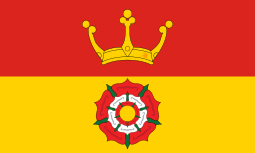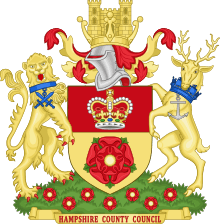Hampshire
Hampshire (/ˈhæmpʃər/, /-ʃɪər/ (![]()
| Hampshire | |||||
|---|---|---|---|---|---|
| Ceremonial county | |||||
| |||||
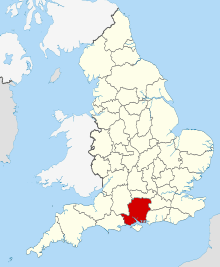 | |||||
| Coordinates: 51°03′28″N 1°18′29″W | |||||
| Sovereign state | United Kingdom | ||||
| Constituent country | England | ||||
| Region | South East | ||||
| Established | Ancient | ||||
| Ceremonial county | |||||
| Lord Lieutenant | Nigel Atkinson | ||||
| High Sheriff | Revd Susan Colman [1] (2020–21) | ||||
| Area | 3,769 km2 (1,455 sq mi) | ||||
| • Ranked | 7th of 48 | ||||
| Population (mid-2019 est.) | 1,844,245 | ||||
| • Ranked | 6th of 48 | ||||
| Density | 489/km2 (1,270/sq mi) | ||||
| Non-metropolitan county | |||||
| County council | Hampshire County Council | ||||
| Executive | Conservative | ||||
| Admin HQ | Winchester | ||||
| Area | 3,679 km2 (1,420 sq mi) | ||||
| • Ranked | 7th of 26 | ||||
| Population | 1382542 | ||||
| • Ranked | 3th of 26 | ||||
| Density | 376/km2 (970/sq mi) | ||||
| ISO 3166-2 | GB-HAM | ||||
| ONS code | 24 | ||||
| GSS code | E10000014 | ||||
| NUTS | UKJ33 | ||||
| Website | Hampshire Southampton Portsmouth | ||||
| Unitary authorities | |||||
| Councils | Southampton Portsmouth | ||||
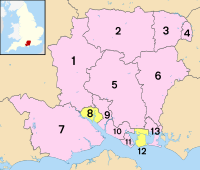 Districts of Hampshire Unitary County council area | |||||
| Districts | |||||
| Members of Parliament | List of MPs | ||||
| Police | Hampshire Constabulary | ||||
| Time zone | Greenwich Mean Time (UTC) | ||||
| • Summer (DST) | British Summer Time (UTC+1) | ||||
First settled about 14,000 years ago, Hampshire's history dates to Roman Britain, when its chief town was Winchester. The county was recorded in the 11th century Domesday Book, divided into 44 hundreds. From the 12th century, the ports grew in importance, fuelled by trade with the continent, wool and cloth manufacture in the county, and the fishing industry, and a shipbuilding industry was established. By the 16th century, the population of Southampton had outstripped that of Winchester. By the mid-19th century, with the county's population at 219,210 (double that at the beginning of the century) in more than 86,000 dwellings, agriculture was the principal industry and 10 per cent of the county was still forest. Hampshire played a crucial military role in both World Wars. The borders of the ceremonial county were created by the Local Government Act 1972 (enacted 1974). Historically part of Hampshire, the Isle of Wight, was made a separate ceremonial county and the towns of Bournemouth and Christchurch were administered as part of the ceremonial county of Dorset.
The county's geography is varied, with upland to 286 metres (938 ft) and mostly south-flowing rivers. There are areas of downland and marsh, and two national parks: the New Forest, and part of the South Downs, which together cover 45 per cent of Hampshire.
Hampshire is one of the most affluent counties in the country, with an unemployment rate lower than the national average, and its economy derived from major companies, maritime, agriculture and tourism. Tourist attractions include many seaside resorts, the national parks and the Southampton Boat Show. The county is known as the home of writers Jane Austen and Charles Dickens. Hampshire is also the childhood home of Florence Nightingale and the birthplace of engineer Isambard Kingdom Brunel.
Name
Hampshire takes its name from the settlement that is now the city of Southampton. Southampton was known in Old English as Hamtun, roughly meaning "village-town", so its surrounding area or scīr became known as Hamtunscīr. The old name was recorded in the Domesday book as Hantescire, and from this spelling, the modern abbreviation "Hants" derives.[2] From 1889 until 1959, the administrative county was named the County of Southampton[3][4] and has also been known as Southamptonshire.[5][6]
Hampshire was the departure point of some of those who left England to settle on the east coast of North America during the 17th century, giving its name in particular to the state of New Hampshire.[7]
History
Prehistory until the Norman Conquest
The region is believed to have been continuously occupied since the end of the last Ice Age about 12,000 BCE.[8] At this time, Britain was still attached to the European continent and was predominantly covered with deciduous woodland. The first inhabitants were Mesolithic hunter-gatherers.[9] The majority of the population would have been concentrated around the river valleys.[10] Over several thousand years, the climate became progressively warmer, and sea levels rose; the English Channel, which started out as a river, was a major inlet by 8000 BCE, although Britain was still connected to Europe by a land bridge across the North Sea until 6500 BCE.[11] Notable sites from this period include Bouldnor Cliff.[12]
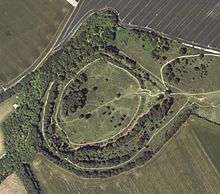
Agriculture had arrived in southern Britain by 4000 BCE, and with it a neolithic culture. Some deforestation took place at that time, although during the Bronze Age, beginning in 2200 BCE, this became more widespread and systematic.[13] Hampshire has few monuments to show from these early periods, although nearby Stonehenge was built in several phases at some time between 3100 and 2200 BCE. In the very late Bronze Age, fortified hilltop settlements known as hillforts began to appear in large numbers in many parts of Britain including Hampshire, and these became more and more important in the early and middle Iron Age;[14] many of these are still visible in the landscape today and can be visited, notably Danebury Rings, the subject of a major study by archaeologist Barry Cunliffe. By this period, the people of Britain predominantly spoke a Celtic language, and their culture shared much in common with the Celts described by classical writers.[15]
Hillforts largely declined in importance in the second half of the second century BCE, with many being abandoned. Probably around this period, the first recorded invasion of Britain took place, as southern Britain was largely conquered by warrior-elites from Belgic tribes of northeastern Gaul - whether these two events are linked to the decline of hillforts is unknown. By the Roman conquest, the oppidum at Venta Belgarum, modern-day Winchester, was the de facto regional administrative centre; Winchester was, however, of secondary importance to the Roman-style town of Calleva Atrebatum, modern Silchester, built further north by a dominant Belgic polity known as the Atrebates in the 50s BCE. Julius Caesar invaded southeastern England briefly in 55 and again in 54 BCE, but he never reached Hampshire. Notable sites from this period include Hengistbury Head (now in Dorset), which was a major port.[14][16]
The Romans invaded Britain again in 43 CE, and Hampshire was incorporated into the Roman province of Britannia very quickly. It is generally believed their political leaders allowed themselves to be incorporated peacefully. Venta became the capital of the administrative polity of the Belgae, which included most of Hampshire and Wiltshire and reached as far as Bath. Whether the people of Hampshire played any role in Boudicca's rebellion of 60-61 is not recorded, but evidence of burning is seen in Winchester dated to around this period.[17] For most of the next three centuries, southern Britain enjoyed relative peace. The later part of the Roman period had most towns build defensive walls; a pottery industry based in the New Forest exported items widely across southern Britain. A fortification near Southampton was called Clausentum, part of the Saxon Shore forts, traditionally seen as defences against maritime raids by Germanic tribes. The Romans withdrew from Britain in 410.[18][19][20]
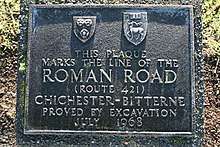
Two major Roman roads, Ermin Way and Port Way cross the north of the country connecting Calleva Atrebatum with Corinium Dobunnorum, modern Cirencester, and Old Sarum respectively. Other roads connected Venta Belgarum with Old Sarum, Wickham and Clausentum. A road, presumed to diverge from the Chichester to Silchester Way at Wickham, connected Noviomagus Reginorum, modern Chichester, with Clausentum.[21]
Records are unreliable for the next 200 years, but in this time, southern Britain went from being Brythonic to being English and Hampshire emerged as the centre of what was to become the most powerful kingdom in Britain, the Kingdom of Wessex. Evidence of early Anglo-Saxon settlement has been found at Clausentum, dated to the fifth century. By the seventh century, the population of Hampshire was predominantly English-speaking; around this period, the administrative region of "Hampshire" seems to appear; the name is attested as "Hamtunscir" in 755,[22] and Albany Major suggested that the traditional western and northern borders of Hampshire may even go back to the very earliest conquests of Cerdic, legendary founder of Wessex, at the beginning of the sixth century.[23] Wessex, with its capital at Winchester,[24] gradually expanded westwards into Brythonic Dorset and Somerset in the seventh century. A statue in Winchester celebrates the powerful King Alfred, who repulsed the Vikings and stabilised the region in the 9th century. A scholar as well as a soldier, the Anglo-Saxon Chronicle, a powerful tool in the development of the English identity, was commissioned in his reign. King Alfred proclaimed himself "King of England" in 886; but Athelstan of Wessex did not officially control the whole of England until 927.[18][20][25][26]
Middle Ages onwards

By the Norman conquest, London had overtaken Winchester as the largest city in England[25] and after the Norman Conquest, King William I made London his capital. While the centre of political power moved away from Hampshire, Winchester remained an important city; the proximity of the New Forest to Winchester made it a prized royal hunting forest; King William Rufus was killed while hunting there in 1100. There were 44 hundreds, covering 483 named places, recorded in the Domesday Book of 1086 which are in present-day Hampshire and part of Sussex.[27] From the 12th century, the ports grew in importance, fuelled by trade with the continent, wool and cloth manufacture in the county, and the fishing industry, and a shipbuilding industry was established. By 1523 at the latest, the population of Southampton had outstripped that of Winchester.
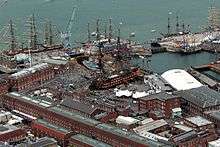
Over several centuries, a series of castles and forts was constructed along the coast of the Solent to defend the harbours at Southampton and Portsmouth. These include the Roman Portchester Castle which overlooks Portsmouth Harbour, and a series of forts built by Henry VIII including Hurst Castle, situated on a sand spit at the mouth of the Solent, Calshot Castle on another spit at the mouth of Southampton Water, and Netley Castle. Southampton and Portsmouth remained important harbours when rivals, such as Poole and Bristol, declined, as they are amongst the few locations that combine shelter with deep water. Mayflower and Speedwell set sail for America from Southampton in 1620.[28]
During the English Civil War (1642-1651) there were several skirmishes in Hampshire between the Royalist and Parliamentarian forces. Principal engagements were the Siege of Basing House between 1643 and 1645, and the Battle of Cheriton in 1644; both were significant Parliamentarian victories. Other clashes included the Battle of Alton in 1643, where the commander of the Royalist forces was killed in the pulpit of the parish church,[29] and the Siege of Portsmouth in 1642.[30]
By the mid-19th century, with the county's population at 219,210 (double that at the beginning of the century) in more than 86,000 dwellings, agriculture was the principal industry (10 per cent of the county was still forest) with cereals, peas, hops, honey, sheep and hogs important. Due to Hampshire's long association with pigs and boars, natives of the county have been known as Hampshire hogs since the 18th century.[31] In the eastern part of the county the principal port was Portsmouth (with its naval base, population 95,000), while several ports (including Southampton, with its steam docks, population 47,000) in the western part were significant. In 1868, the number of people employed in manufacture exceeded those in agriculture, engaged in silk, paper, sugar and lace industries, ship building and salt works. Coastal towns engaged in fishing and exporting agricultural produce. Several places were popular for seasonal sea bathing.[6] The ports employed large numbers of workers, both land-based and seagoing; Titanic, lost on her maiden voyage in 1912, was crewed largely by residents of Southampton.[32]
On 16 October 1908, Samuel Franklin Cody made the first powered flight of 400 yd (370 m) in the United Kingdom at Farnborough, then home to the Army Balloon Factory.[33]
After 1914
Hampshire played a crucial role in both World Wars due to the large Royal Navy naval base at Portsmouth, the army camp at Aldershot, and the military Netley Hospital on Southampton Water, as well as its proximity to the army training ranges on Salisbury Plain and the Isle of Purbeck. Supermarine, the designers of the Spitfire and other military aircraft, were based in Southampton, which led to severe bombing of the city in World War 2. Aldershot remains one of the British Army's main permanent camps. Farnborough is a major centre for the aviation industry.
During the Second World War, the Beaulieu, Hampshire Estate of Lord Montagu in the New Forest was the site of several group B finishing schools for agents[34] operated by the Special Operations Executive (SOE) between 1941 and 1945. (One of the trainers was Kim Philby who was later found to be part of a spy ring passing information to the Soviets.) In 2005, a special exhibition was established at the Estate, with a video showing photographs from that era as well as voice recordings of former SOE trainers and agents.[35][36]
Although the Isle of Wight has at times been part of Hampshire, it has been administratively independent for over a century, obtaining a county council of its own in 1890. The Isle of Wight became a full ceremonial county in 1974. Apart from a shared police force, no formal administrative links now exist between the Isle of Wight and Hampshire, though many organisations still combine Hampshire and the Isle of Wight.
In the 1970s, local government reorganisation led to a reduction in Hampshire's size; in 1974, the towns of Bournemouth and Christchurch were transferred to Dorset.[37]
Geography
Hampshire is bordered by Dorset to the west, Wiltshire to the north-west, Berkshire to the north, Surrey to the north-east, and West Sussex to the east. The southern boundary is the coastline of the English Channel and the Solent, facing the Isle of Wight. It is the largest county in South East England and remains the third largest shire county in the United Kingdom despite losing more land than any other English county in all contemporary boundary changes. At its greatest size in 1890, Hampshire was the fifth-largest county in England. It now has an overall area of 3,700 km2 (1,400 sq mi),[38] and measures about 86 km (53 mi) east–west and 76 km (47 mi) north–south.[39]
Geology
Hampshire's geology falls into two categories. In the south, along the coast is the "Hampshire Basin", an area of relatively non-resistant Eocene and Oligocene clays and gravels which are protected from sea erosion by the Isle of Purbeck, Dorset, and the Isle of Wight. These low, flat lands support heathland and woodland habitats, a large area of which forms part of the New Forest. The New Forest has a mosaic of heathland, grassland, coniferous and deciduous woodland habitats that host diverse wildlife. The forest is protected as a national park, limiting development and agricultural use to protect the landscape and wildlife. Large areas of the New Forest are open common lands kept as a grassland plagioclimax by grazing animals, including domesticated cattle, pigs and horses, and several wild deer species. Erosion of the weak rock and sea level change flooding the low land has carved several large estuaries and rias, notably the 16 km (9.9 mi) long[40] Southampton Water and the large convoluted Portsmouth Harbour. The Isle of Wight lies off the coast of Hampshire where the non-resistant rock has been eroded away, forming the Solent.
A 2014 study found that Hampshire shares significant reserves of shale oil with other neighbouring counties, totalling 4.4 billion barrels of oil, which then Business and Energy Minister Michael Fallon said "will bring jobs and business opportunities" and significantly help with UK energy self-sufficiency. Fracking in the area is required to achieve these objectives, which has been opposed by environmental groups.[41]
Natural regions
Natural England identifies a number of national character areas that lie wholly or partially in Hampshire: the Hampshire Downs, New Forest, South Hampshire Lowlands, South Coast Plain, South Downs, Low Weald and Thames Basin Heaths[42]
Green belt
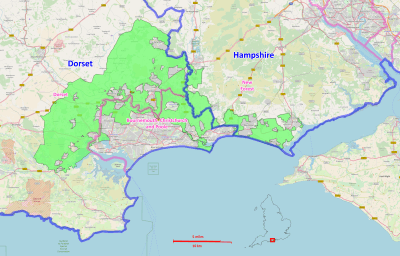
Hampshire contains all its green belt in the New Forest district, in the southwest of the county, from the boundary with Dorset along the coastline to Lymington and northwards to Ringwood. Its boundary is contiguous with the New Forest National Park. The Hampshire portion was first created in 1958.[43] Its function is to control expansion in the South East Dorset conurbation and outlying towns and villages.[44]
Hills
The highest point in Hampshire is Pilot Hill at 286 metres (938 ft), in the northwest corner of the county, bordering Berkshire, and there are some 20 other hills exceeding 200 metres (660 ft). Butser Hill, at 271 metres (889 ft), where the A3 crosses the South Downs, is probably the best known. In the north and centre of the county the substrate is the rocks of the Chalk Group, which form the Hampshire Downs and the South Downs. These are high hills with steep slopes where they border the clays to the south. The hills dip steeply forming a scarp onto the Thames valley to the north, and dip gently to the south. The highest village in Hampshire at about 240 metres (790 ft) above sea level is Ashmansworth,[45] located between Andover and Newbury.
Rivers
The Itchen and Test are trout rivers that flow from the chalk through wooded valleys into Southampton Water. Other important watercourses are the Hamble, Meon, Beaulieu and Lymington rivers. The Hampshire Avon, which links Stonehenge to the sea, passes through Fordingbridge and Ringwood and then forms the modern border between Hampshire and Dorset. The northern branch of the River Wey has its source near Alton and flows east past Bentley.[46] The River Loddon rises at West Ham Farm and flows north through Basingstoke.[47]
Wildlife

Hampshire's downland supports a calcareous grassland habitat, important for wild flowers and insects. A large area of the downs is now protected from further agricultural damage by the East Hampshire Area of Outstanding Natural Beauty. The River Test has a growing number of otters as, increasingly, does the Itchen,[48] although other areas of the county have quite low numbers. There are wild boar kept for meat[49] in the New Forest, which is known for its ponies and herds of fallow deer, red deer, roe deer, and sika deer as well as a small number of muntjac deer.[50] The deer had been hunted for some 900 years until 1997.[51] An unwelcome relative newcomer is the mink population, descended from animals that escaped or were deliberately released from fur farms since the 1950s, which cause havoc amongst native wildlife.[52][53]
Farlington Marshes, 125 hectares (310 acres) of flower-rich grazing marsh and saline lagoon at the north end of Langstone Harbour, is a nature reserve and an internationally important over-wintering site for wildfowl.[54] In a valley on the downs is Selborne; the countryside surrounding the village was the location of Gilbert White's pioneering observations on natural history.[55] Hampshire's county flower is the Dog Rose.[56]
Climate
Hampshire has a milder climate than most areas of the British Isles,[57] being in the far south with the climate stabilising effect of the sea, but protected against the more extreme weather of the Atlantic coast. Hampshire has a higher average annual temperature than the UK average at 9.8 to 12 °C (49.6 to 53.6 °F),[58] average rainfall at 640–1,060 millimetres (25–42 in) per year,[59] and holds higher than average sunshine totals of around 1,750 hours[60] of sunshine per year.[61]
| Climate data for Southampton, elevation 3 m, 1981–2010 | |||||||||||||
|---|---|---|---|---|---|---|---|---|---|---|---|---|---|
| Month | Jan | Feb | Mar | Apr | May | Jun | Jul | Aug | Sep | Oct | Nov | Dec | Year |
| Average high °C (°F) | 8.4 (47.1) |
8.6 (47.5) |
11.1 (52.0) |
14.0 (57.2) |
17.5 (63.5) |
20.2 (68.4) |
22.4 (72.3) |
22.3 (72.1) |
19.8 (67.6) |
15.6 (60.1) |
11.7 (53.1) |
8.9 (48.0) |
15.1 (59.2) |
| Average low °C (°F) | 2.9 (37.2) |
2.6 (36.7) |
4.1 (39.4) |
5.7 (42.3) |
9.0 (48.2) |
11.7 (53.1) |
13.7 (56.7) |
13.7 (56.7) |
11.4 (52.5) |
8.9 (48.0) |
5.4 (41.7) |
3.2 (37.8) |
7.7 (45.9) |
| Average rainfall mm (inches) | 81.4 (3.20) |
58.3 (2.30) |
60.0 (2.36) |
50.7 (2.00) |
49.0 (1.93) |
50.4 (1.98) |
42.0 (1.65) |
50.4 (1.98) |
60.4 (2.38) |
93.8 (3.69) |
94.0 (3.70) |
89.2 (3.51) |
779.4 (30.69) |
| Average rainy days (≥ 1.0 mm) | 12.2 | 9.2 | 10.1 | 8.8 | 8.2 | 7.7 | 7.4 | 7.7 | 8.7 | 11.5 | 11.5 | 11.8 | 114.7 |
| Mean monthly sunshine hours | 63.3 | 84.4 | 118.3 | 179.8 | 212.1 | 211.2 | 221.8 | 207.7 | 148.1 | 113.0 | 76.6 | 52.9 | 1,689.3 |
| Source 1: Met Office (normals)[62] and Met Office[63] | |||||||||||||
| Source 2: Calculated from Met Office Data[64] | |||||||||||||
| Climate data for Southsea, Portsmouth 1976-2006 | |||||||||||||
|---|---|---|---|---|---|---|---|---|---|---|---|---|---|
| Month | Jan | Feb | Mar | Apr | May | Jun | Jul | Aug | Sep | Oct | Nov | Dec | Year |
| Average high °C (°F) | 9.6 (49.3) |
8.8 (47.8) |
10.6 (51.1) |
13.4 (56.1) |
16.8 (62.2) |
19.4 (66.9) |
21.8 (71.2) |
21.8 (71.2) |
19.3 (66.7) |
15.8 (60.4) |
12.0 (53.6) |
10.0 (50.0) |
14.9 (58.9) |
| Average low °C (°F) | 5.1 (41.2) |
4.3 (39.7) |
5.4 (41.7) |
6.4 (43.5) |
9.6 (49.3) |
12.3 (54.1) |
15.0 (59.0) |
15.0 (59.0) |
12.8 (55.0) |
10.9 (51.6) |
7.5 (45.5) |
5.9 (42.6) |
9.2 (48.5) |
| Average precipitation mm (inches) | 65 (2.6) |
50 (2.0) |
52 (2.0) |
42 (1.7) |
28 (1.1) |
40 (1.6) |
32 (1.3) |
43 (1.7) |
62 (2.4) |
81 (3.2) |
72 (2.8) |
80 (3.1) |
647 (25.5) |
| Average rainy days | 11.2 | 9.5 | 8.3 | 7.6 | 6.5 | 7.4 | 5.4 | 6.6 | 8.5 | 10.9 | 10.3 | 11.2 | 103.4 |
| Mean monthly sunshine hours | 67.9 | 89.6 | 132.7 | 200.5 | 240.8 | 247.6 | 261.8 | 240.7 | 172.9 | 121.8 | 82.3 | 60.5 | 1,919.1 |
| Percent possible sunshine | 26 | 31 | 36 | 49 | 51 | 51 | 54 | 54 | 46 | 38 | 31 | 25 | 41 |
| Source: Met Office[63] | |||||||||||||
| Climate data for Leckford, Andover elevation 117m, 1971-2000, extremes 1960-2007 | |||||||||||||
|---|---|---|---|---|---|---|---|---|---|---|---|---|---|
| Month | Jan | Feb | Mar | Apr | May | Jun | Jul | Aug | Sep | Oct | Nov | Dec | Year |
| Record high °C (°F) | 13.5 (56.3) |
15.4 (59.7) |
20.0 (68.0) |
25.3 (77.5) |
27.2 (81.0) |
33.5 (92.3) |
33.8 (92.8) |
34.7 (94.5) |
28.9 (84.0) |
24.0 (75.2) |
17.0 (62.6) |
14.9 (58.8) |
34.7 (94.5) |
| Average high °C (°F) | 7.0 (44.6) |
7.3 (45.1) |
9.9 (49.8) |
12.6 (54.7) |
16.3 (61.3) |
18.9 (66.0) |
21.8 (71.2) |
21.8 (71.2) |
18.3 (64.9) |
14.0 (57.2) |
9.9 (49.8) |
7.8 (46.0) |
13.8 (56.8) |
| Average low °C (°F) | 1.2 (34.2) |
1.0 (33.8) |
2.6 (36.7) |
3.7 (38.7) |
6.5 (43.7) |
9.1 (48.4) |
11.3 (52.3) |
11.4 (52.5) |
9.5 (49.1) |
6.9 (44.4) |
3.7 (38.7) |
2.2 (36.0) |
5.8 (42.4) |
| Record low °C (°F) | −13.9 (7.0) |
−10.5 (13.1) |
−8.3 (17.1) |
−5.6 (21.9) |
−2.2 (28.0) |
0.6 (33.1) |
3.3 (37.9) |
4.4 (39.9) |
1.0 (33.8) |
−3.1 (26.4) |
−7.5 (18.5) |
−15.6 (3.9) |
−15.6 (3.9) |
| Average precipitation mm (inches) | 88.07 (3.47) |
58.81 (2.32) |
63.31 (2.49) |
51.93 (2.04) |
50.85 (2.00) |
59.27 (2.33) |
42.57 (1.68) |
59.22 (2.33) |
69.60 (2.74) |
84.06 (3.31) |
82.12 (3.23) |
94.9 (3.74) |
804.71 (31.68) |
| Source: KNMI[65] | |||||||||||||
| Climate data for Solent MRSC 1980-2010 | |||||||||||||
|---|---|---|---|---|---|---|---|---|---|---|---|---|---|
| Month | Jan | Feb | Mar | Apr | May | Jun | Jul | Aug | Sep | Oct | Nov | Dec | Year |
| Average high °C (°F) | 8.2 (46.8) |
8.2 (46.8) |
10.5 (50.9) |
13.2 (55.8) |
16.7 (62.1) |
19.2 (66.6) |
21.4 (70.5) |
21.4 (70.5) |
19.0 (66.2) |
15.5 (59.9) |
11.5 (52.7) |
8.7 (47.7) |
14.5 (58.0) |
| Average low °C (°F) | 3.4 (38.1) |
2.8 (37.0) |
4.5 (40.1) |
6.1 (43.0) |
9.2 (48.6) |
12.1 (53.8) |
14.2 (57.6) |
14.3 (57.7) |
12.2 (54.0) |
9.6 (49.3) |
6.2 (43.2) |
3.8 (38.8) |
8.2 (46.8) |
| Average precipitation mm (inches) | 68.8 (2.71) |
49.3 (1.94) |
51.6 (2.03) |
42.4 (1.67) |
43.4 (1.71) |
42.0 (1.65) |
44.5 (1.75) |
50.0 (1.97) |
53.7 (2.11) |
86.2 (3.39) |
83.2 (3.28) |
83.9 (3.30) |
699 (27.51) |
| Source: UK Met Office[66] | |||||||||||||
| Climate data for Farnborough, Hampshire, UK | |||||||||||||
|---|---|---|---|---|---|---|---|---|---|---|---|---|---|
| Month | Jan | Feb | Mar | Apr | May | Jun | Jul | Aug | Sep | Oct | Nov | Dec | Year |
| Average high °C (°F) | 8 (46) |
8 (46) |
11 (51) |
13 (56) |
17 (63) |
20 (68) |
22 (72) |
22 (72) |
19 (66) |
15 (59) |
11 (51) |
8 (47) |
15 (58) |
| Average low °C (°F) | 2 (36) |
2 (36) |
3 (37) |
4 (39) |
7 (45) |
10 (50) |
12 (54) |
12 (54) |
10 (50) |
7 (45) |
4 (39) |
3 (37) |
6 (44) |
| Average precipitation mm (inches) | 62 (2.46) |
41 (1.60) |
48 (1.88) |
47 (1.87) |
51 (2.01) |
52 (2.03) |
40 (1.56) |
49 (1.94) |
61 (2.41) |
71 (2.80) |
60 (2.37) |
65 (2.54) |
647 (25.47) |
| Source: Weather.com[67] | |||||||||||||
Settlements
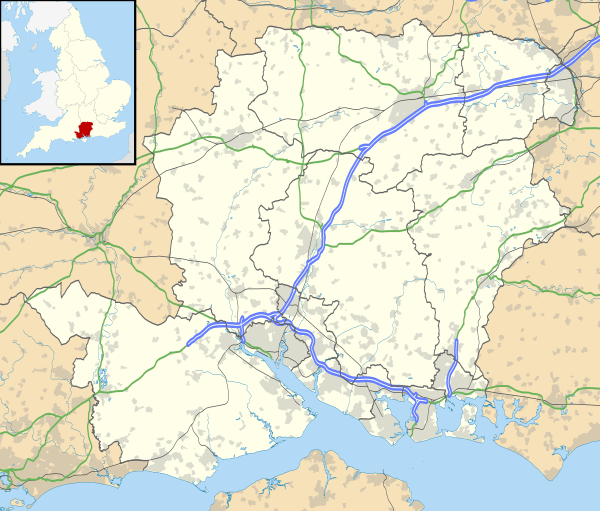
For the complete list of settlements see List of places in Hampshire and List of settlements in Hampshire by population.
Hampshire's county town is Winchester, a historic city that was once the capital of the ancient kingdom of Wessex and of England until the Norman conquest of England. The port cities of Southampton and Portsmouth were split off as independent unitary authorities in 1997, although they are still included in Hampshire for ceremonial purposes. Fareham, Gosport and Havant have grown into a conurbation that stretches along the coast between the two main cities. The three cities are all university cities, Southampton being home to the University of Southampton and Southampton Solent University (formerly Southampton Institute), Portsmouth to the University of Portsmouth, and Winchester to the University of Winchester (formerly known as University College Winchester; King Alfred's College). The northeast of the county houses the Blackwater Valley conurbation, which includes the towns of Farnborough, Aldershot, Blackwater and Yateley and borders both Berkshire and Surrey.
Hampshire lies outside the green belt area of restricted development around London, but has good railway and motorway links to the capital, and in common with the rest of the south-east has seen the growth of dormitory towns since the 1960s. Basingstoke, in the northern part of the county, has grown from a country town into a business and financial centre. Aldershot, Portsmouth, and Farnborough have strong military associations with the Army, Royal Navy, and Royal Air Force respectively. The county also includes several market towns: Alresford, Alton, Andover, Bishop's Waltham, Lymington, New Milton, Petersfield, Ringwood, Romsey and Whitchurch.
Demographics
Population
At the 2001 census[68] the ceremonial county recorded a population of 1,644,249, of which 1,240,103 were in the administrative county, 217,445 were in the unitary authority of Southampton, and 186,701 were in Portsmouth. The population of the administrative county grew 5.6 per cent from the 1991 census and Southampton grew 6.2 per cent (Portsmouth remained unchanged), compared with 2.6 per cent for England and Wales as a whole. Eastleigh and Winchester grew fastest at 9 per cent each.
Southampton and Portsmouth are the main settlements within the South Hampshire conurbation, which is home to about half of the ceremonial county's population.[69] The larger South Hampshire metropolitan area has a population of 1,547,000.[70]
Cities and towns by population size: (2001 census)
- Southampton – 244,224
- Portsmouth – 207,100
- Basingstoke – 90,171 (town), 152,573 (borough)
- Gosport – 69,348 (town), 77,000 (borough)
- Andover – 64,000
- Waterlooville – 63,558
- Aldershot – 58,120
- Farnborough – 57,147
- Fareham/Portchester – 56,010 (town), 109,619 (borough)
- Eastleigh – 52,894 (town), 116,177 (borough)
- Havant – 45,435 (town), 115,300 (borough)
- Winchester – 41,420 (city), 116,600 (district)
- Fleet – 32,726
- Petersfield-14,974 (town)
The table below shows the population change up to the 2011 census, contrasting the previous census. It also shows the proportion of residents in each district reliant upon lowest income and/or joblessness benefits, the national average proportion of which was 4.5 per cent (August 2012). The most populous district of Hampshire is New Forest District.
| Unit | JSA or Inc. Supp. claimants (August 2012) % of 2011 population | JSA and Income Support claimants (August 2001) % of 2001 population | Population (April 2011) | Population (April 2001) |
|---|---|---|---|---|
| Hampshire | 2.4% | 4.3% | 1,317,788 | 1,240,103 |
| Ranked by district | ||||
| Borough of Havant | 4.1% | 7.2% | 120,684 | 116,849 |
| Borough of Gosport | 3.7% | 5.7% | 82,622 | 76,415 |
| Borough of Rushmoor | 2.9% | 4.1% | 93,807 | 90,987 |
| Borough of Basingstoke and Deane | 2.6% | 3.8% | 167,799 | 152,573 |
| Borough of Eastleigh | 2.3% | 4.0% | 125,199 | 116,169 |
| New Forest District | 2.2% | 4.7% | 176,462 | 169,331 |
| Borough of Fareham | 2.0% | 3.7% | 111,581 | 107,977 |
| Borough of Test Valley | 2.0% | 3.8% | 116,398 | 109,801 |
| East Hampshire District | 1.8% | 4.0% | 115,608 | 109,274 |
| Winchester District | 1.7% | 3.6% | 116,595 | 107,222 |
| Hart District | 1.3% | 2.3% | 91,033 | 83,505 |
Ethnicity and religion
At the 2011 census, about 89 per cent of residents were white British, falling to 85.87 per cent in Southampton. The significant ethnic minorities were Asian at 2.6 per cent and mixed race at 1.4 per cent; 10 per cent of residents were born outside the UK. 59.7 per cent stated their religion as Christian and 29.5 per cent as not religious. Significant minority religions were Islam (1.46 per cent) and Hinduism (0.73 per cent).[72]
The Church of England Diocese of Winchester was founded in 676AD and covers about two thirds of Hampshire and extends into Dorset.[73] Smaller parts of Hampshire are covered by the dioceses of Portsmouth, Guildford and Oxford.
The Roman Catholic Diocese of Portsmouth covers Hampshire as well as the Isle of Wight and the Channel Islands.[74]
Politics

With the exceptions of the unitary authorities of Portsmouth and Southampton, Hampshire is governed by Hampshire County Council based at Castle Hill in Winchester, with eleven non-metropolitan districts beneath it and, for the majority of the county, parish councils or town councils at the local level.
Hampshire contains two national parks; the New Forest is wholly within the county, and the South Downs National Park embraces parts of Hampshire, West Sussex and East Sussex; they are each overseen by a national park authority.
In the 2016 United Kingdom European Union membership referendum, Hampshire voted in favour of Brexit.[75][76]
Parliament
Hampshire elects eighteen Members of Parliament. As of the 2019 General Election, sixteen MPs are Conservative and two MPs are Labour.
| 2019 General Election Results in Hampshire | |||||||||
|---|---|---|---|---|---|---|---|---|---|
| Party | Votes | % | Seats | % change from 2017 | Votes in 2017 | Vote change from 2017 | |||
| Conservatives | 512,681 | 57.4% | 16 | 525,222 | |||||
| Liberal Democrats | 172,670 | 19.3% | 0 | 114,794 | |||||
| Labour | 169,284 | 19% | 2 | 241,562 | |||||
| Greens | 29,670 | 3.3% | 0 | 19,932 | |||||
| Others | 8,586 | 1% | 0 | 30,508 | |||||
| Total | 892,891 | 100.0 | 18 | 932,018 | |||||
In the 2019 General Election there were no seat changes, with the 16 Conservative constituencies and 2 Labour constituencies holding on to the same seats won or held in 2017. This is despite the Liberal Democrats gaining 57,876 more votes (an increase of 50.4%) compared to 2017, and Labour losing 72,278 votes (29.9%) compared to 2017.
At the 2017 General Election, the Conservatives won 16 seats, continuing their dominance in the county. Labour took two seats, Southampton Test and Portsmouth South. In the 2015 general election, every Hampshire seat except Southampton Test (Labour) was won by the Conservatives. In 2010, 14 constituencies were represented by Conservative Members of Parliament (MPs), two by the Liberal Democrats, and two by Labour. Labour represented the largest urban centre, holding both Southampton constituencies (Test and Itchen). The Liberal Democrats held Portsmouth South and Eastleigh.
The Conservatives represent a mix of rural and urban areas: Aldershot, Basingstoke, East Hampshire, Fareham, Gosport, Havant, Meon Valley, North East Hampshire, North West Hampshire, New Forest East, New Forest West, Portsmouth North, Romsey and Southampton North and Winchester.
At the 2013 local elections for Hampshire County Council, the Conservative Party had a 37.51 per cent share of the votes, the Liberal Democrats 21.71 per cent, the UK Independence Party 24.61 per cent and Labour 10 per cent. As a result, 45 Conservatives, 17 Liberal Democrats, 10 UKIP, four Labour and one Community Campaign councillor sit on the County Council.[77] Southampton City Council, which is a separate Unitary Authority, has 28 Labour, 16 Conservative, 2 Councillors Against the Cuts and 2 Liberal Democrat councillors.[78] Portsmouth City Council, also a UA, has 25 Liberal Democrat, 12 Conservative and 5 Labour councillors.[79]
Hampshire has its own County Youth Council (HCYC)[80] and is an independent youth-run organisation. It meets once a month around Hampshire and aims to give the young people of Hampshire a voice. It also has numerous district and borough youth councils including Basingstoke's "Basingstoke & Deane Youth Council".[81]
Emergency services
- Hampshire Fire and Rescue Service
- South Central Ambulance Service
- South East Coast Ambulance Service
- Hampshire & Isle of Wight Air Ambulance
- Hampshire Constabulary
- British Transport Police
- HM Coastguard
Economy
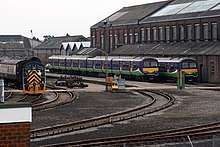
Hampshire is one of the most affluent counties in the country, with a gross domestic product (GDP) of £29 billion, excluding Southampton and Portsmouth. In 2018, Hampshire had a GDP per capita of £22,100, comparable with the UK as a whole.[82]
Portsmouth and Winchester have the highest job densities in the county; 38 per cent of workplace workers in Portsmouth commuted into the city in 2011.[83] Southampton has the highest number of total jobs and commuting both into and out of the city is high. The county has a lower level of unemployment than the national average, at 1.3 per cent when the national rate is 2.1 per cent, as of February 2018.[84] About one third are employed by large firms. Hampshire has a considerably higher than national average employment in high-tech industries, but average levels in knowledge-based industry. About 25 per cent of the population work in the public sector. Tourism accounts for some 60,000 jobs in the county, around 9 per cent of the total.[82]
One of the principal companies in the high tech sector is IBM which has its research and development laboratories at Hursley and its UK headquarters at Cosham.
Many rural areas of Hampshire have traditionally been reliant on agriculture, particularly dairy farming, although the significance of agriculture as a rural employer and rural wealth creator has declined since the first half of the 20th century and agriculture currently employs 1.32 per cent of the rural population.
The extractive industries deal principally with sand, gravel, clay and hydrocarbons. There are three active oilfields in Hampshire with one being also used as a natural gas store. These are in the west of the county in the Wessex Basin. The Weald Basin to the east has potential as a source of shale oil but is not currently exploited.[85]
The New Forest area is a national park, and tourism is a significant economic segment in this area, with 7.5 million visitors in 1992.[86] The South Downs and the cities of Portsmouth, Southampton, and Winchester also attract tourists to the county. Southampton Boat Show is one of the biggest annual events held in the county, and attracts visitors from throughout the country. In 2003, the county had a total of 31 million day visits, and 4.2 million longer stays.[87]

The cities of Southampton and Portsmouth are both significant ports, with Southampton Docks handling a large proportion of the national container freight traffic as well as being a major base for cruise liners, and Portsmouth Harbour accommodating one of the Royal Navy's main bases and a terminal for cross-channel ferries to France and Spain. The docks have traditionally been large employers in these cities, though mechanisation of cargo handling has led to a reduction in manpower needed.
The Marine Accident Investigation Branch has its principal offices in Southampton,[88] while the Air Accidents Investigation Branch has its head office in Farnborough in Rushmoor District .[89] The Rail Accident Investigation Branch has one of its two offices at Farnborough.[90]
Transport
Air
Southampton Airport, with an accompanying main line railway station, is an international airport situated in the Borough of Eastleigh, close to Swaythling in the city of Southampton. The Farnborough International Airshow is a week-long event that combines a major trade exhibition for the aerospace and defence industries with a public airshow. The event is held in mid-July in even-numbered years at Farnborough Airport. The first five days (Monday to Friday) are dedicated to trade, with the final two days open to the public.[91]
Sea
Cross-channel and cross-Solent ferries from Southampton, Portsmouth and Lymington link the county to the Isle of Wight, the Channel Islands and continental Europe.
Rail
The South Western Main Line (operated by South Western Railway) from London to Weymouth runs through Winchester and Southampton, and the Wessex Main Line from Bristol to Portsmouth also runs through the county as does the Portsmouth Direct Line.
Road
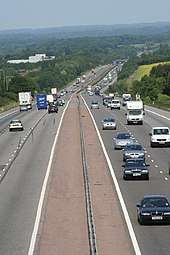
The M3 motorway bisects the county from the southwest, at the edge of the New Forest near Southampton, to the northeast on its way to connect with the M25 London orbital motorway. At its southern end it links with the M27 south coast motorway. The construction of the Twyford Down cutting near Winchester caused major controversy by cutting through a series of ancient trackways and other features of archaeological significance.[92] The M27 serves as a bypass for the major conurbations and as a link to other settlements on the south coast. Other important roads include the A27, A3, A31, A34, A36 and A303.
The county has a high level of car ownership, with only 15.7 per cent having no access to a private car compared with 26.8 per cent for England and Wales. The county has a lower than average use of trains (3.2 compared with 4.1 per cent for commuting) and buses (3.2 to 7.4 per cent), but a higher than average use of bicycles (3.5 to 2.7 per cent) and cars (63.5 to 55.3 per cent).[93]
Inland waterways
Hampshire formerly had several canals,[6] but most of these have been abandoned and their routes built over. The Basingstoke Canal has been extensively restored, and is now navigable for most of its route, but the Salisbury and Southampton Canal, Andover Canal and Portsmouth and Arundel Canal have all disappeared. Restoration of the Itchen Navigation, linking Southampton and Winchester, primarily as a wildlife corridor, began in 2008.
Education
The school system in Hampshire (including Southampton and Portsmouth) is comprehensive. Geographically inside the Hampshire LEA are 24 independent schools, Southampton has three and Portsmouth has four. Few Hampshire schools have sixth forms, which varies by district council. There are 14 further education colleges within the Hampshire LEA, including six graded as 'outstanding' by Ofsted: Alton College, Barton Peveril Sixth Form College, Brockenhurst College, Farnborough College of Technology, Farnborough Sixth Form College, Peter Symonds College, Queen Mary's College, and South Downs College.
The four universities are the University of Southampton, Southampton Solent University, the University of Portsmouth, and the University of Winchester (which also had a small campus in Basingstoke until 2011). Farnborough College of Technology awards University of Surrey-accredited degrees.
Health
There are major NHS hospitals in each of the cities, and smaller hospitals in several towns,[94] as well as a number of private hospitals. Southern Health NHS Foundation Trust coordinates public health services,[95] while Hampshire Hospitals NHS Foundation Trust coordinates hospital services.[96]
Culture, arts and sport
Flag
The Flag of Hampshire was officially added to the Flag Institute's registry of flags on 12 March 2019 after receiving support from Hampshire County Council, the Lord Lieutenant of Hampshire, and many local organisations.[97] The county day and flag day is 15 July, St Swithun's Day; St Swithun was an Anglo-Saxon bishop of Winchester.
Music
Hampshire is the home of many orchestras, bands, and groups. Musician Laura Marling hails originally from Hampshire. The Hampshire County Youth Choir is based in Winchester, and has had successful tours of Canada and Italy in recent years. The Hampshire County Youth Orchestra (with its associated chamber orchestra and string orchestra) is based at Thornden Hall.
Museums
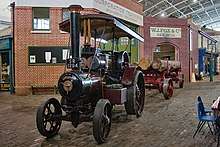
There are a number of local museums, such as the City Museum in Winchester, which covers the Iron Age and Roman periods, the Middle Ages, and the Victorian period over three floors. A "Museum of the Iron Age" is in Andover. Southampton's Sea City Museum is primarily focused on the City's links with the Titanic. Basingstoke's Milestones Museum records the County's industrial heritage. There are also a number of national museums in Hampshire. The National Motor Museum is located in the New Forest at Beaulieu. The Royal Navy Museum is part of Portsmouth Historic Dockyard. Other military museums include The Submarine Museum at Gosport, the Royal Marines Museum, originally in Southsea but due to transfer to the Dockyard in 2019, the Aldershot Military Museum, the D-Day Story by Southsea Castle and the Museum of Army Flying at Middle Wallop. Several museums and historic buildings in Hampshire are the responsibility of the Hampshire Cultural Trust.[98] Specialist museums include the Gilbert White museum in his old home in Selborne, which also includes The Oates Collection, dedicated to the explorer Lawrence Oates.
Annual events
The New Forest and Hampshire County Show takes place annually at the end of July; 2020 will mark its centenary.[99] The largest gathering of Muslims in Western Europe, Jalsa Salana, takes place near Alton, with 37,000 visitors in 2017.[100] The ancient festival of Beltain takes place at Butser Ancient Farm in the spring.[101]
Buildings and protected monuments
There are 187 Grade I listed buildings in the county, ranging from statues to farm buildings and churches to castles,[102] 511 buildings listed Grade II*,[103] and many more listed in the Grade II category.[104] National Heritage's figures include the Isle of Wight, listing 208 Grade I buildings, 578 Grade II* and 10,372 Grade II, 731 scheduled monuments, two wrecks, 91 parks and gardens, and a battlefield: the Battle of Cheriton, which took place in 1644, near Winchester.[105]
Sport
The game of cricket was largely developed in south-east England, with one of the first teams forming at Hambledon in 1750, with the Hambledon Club creating many of cricket's early rules. Hampshire County Cricket Club is a first-class team. The main county ground is the Rose Bowl in West End, which has hosted one day internationals and which, following redevelopment, hosted its first test match in 2011.
The world's oldest surviving bowling green is the Southampton Old Bowling Green, which was first used in 1299.[106]
Hampshire's relatively safe waters have allowed the county to develop as one of the busiest sailing areas in the country, with many yacht clubs and several manufacturers on the Solent. The Hamble, Beaulieu and Lymington rivers are major centres for both competitive and recreational sailing, along with Hythe and Ocean Village marinas. The sport of windsurfing was invented at Hayling Island in the south east of the county.[107]

Hampshire has several association football teams, including Premier league side Southampton F.C., EFL League One side Portsmouth F.C. and National league sides Aldershot Town F.C., Eastleigh F.C. and Havant & Waterlooville F.C.. Portsmouth F.C. and Southampton F.C. have traditionally been fierce rivals. Portsmouth won the FA Cup in 1939 and 2008 and the Football League title in 1949 and 1950. Southampton won the FA Cup in 1976 and reached the finals in 1900, 1902, and 2003. Aldershot F.C. were members of the Football League from 1932 to 1992. They were succeeded by Aldershot Town F.C. who in 2008 were crowned the Conference Premier champions and promoted to the Football League, but lost their Football League status after the 2012–13 season. Hampshire has a number of Non League football teams. Bashley, Gosport borough and AFC Totton play in the Southern Football League Premier Division and Sholing F.C. and Winchester City F.C. play in the Southern Football League Division One South and West.
Thruxton Circuit, in the north of the county, is Hampshire's premier motor racing circuit, with a karting circuit; there are other karting circuits at Southampton and Gosport.[108] The other main circuit is the Ringwood Raceway at Matchams.
Lasham Airfield, near Alton, is a major centre for gliding, hosting both regional and national annual competitions.[109]
Media
Television
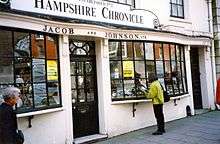
The county's television news is covered by BBC South Today from its studios in Southampton and ITV Meridian from a studio in Whiteley, though both BBC London and ITV London can be received in northern and eastern parts of the county. A local independent television station, That's Hampshire, started transmitting in May 2017.[110]
Radio
Around 25 commercial radio stations cover the area, and BBC Radio Solent looks after the majority of the county, while BBC Surrey can be heard in the north east. University journalism students also "broadcast" bulletins on line for local areas, such as the University of Winchester's WINOL (Winchester News Online), run by students on its BA (Hons) Journalism course.[111]
Press
Southampton and Portsmouth support daily newspapers; the Southern Daily Echo and The News respectively. The Basingstoke Gazette is published three times a week, and there are a number of other papers that publish on a weekly basis, notably the Hampshire Chronicle, one of the oldest newspapers in the country.[112]
Notable people
Possibly the most notable resident was the Duke of Wellington, who lived at Stratfield Saye House in the north of the county from 1817.[113] An eminent Victorian, who made her mark and “came home” to Hampshire for burial at East Wellow was Florence Nightingale.[114]
Hampshire's literary connections include the birthplace of authors Jane Austen, Wilbert Awdry and Charles Dickens, and the residence of others, such as Charles Kingsley and Mrs Gaskell. Austen lived most of her life in Hampshire, where her father was rector of Steventon, and wrote all of her novels in the county. Alice Liddell, also known as Alice Hargreaves, the inspiration for Alice in Lewis Carroll's Alice's Adventures in Wonderland, lived in and around Lyndhurst, Hampshire after her marriage to Reginald Hargreaves, and is buried in the graveyard of St Michael and All Angels Church in the town.[115] Hampshire also has many visual art connections, claiming the painter John Everett Millais as a native, and the cities and countryside have been the subject of paintings by L. S. Lowry and J. M. W. Turner. Selborne was the home of Gilbert White. Journalist and social critic Christopher Hitchens was born into a naval family in Portsmouth. Broadcasters Philippa Forrester, Amanda Lamb and Scott Mills also are from the county. American actor and gameshow host, Richard Dawson, was born and raised here. Richard St. Barbe Baker Founder of the International Tree Foundation and responsible for planting over two billion trees was born in West End.
See also
- Business in Hampshire
- Custos Rotulorum of Hampshire—Keepers of the Rolls
- Hampshire (UK Parliament constituency)—Historical list of MPs for Hampshire constituency
- List of High Sheriffs of Hampshire
- List of churches in Hampshire
- List of Parliamentary constituencies in Hampshire
- List of Lord Lieutenants of Hampshire
- Places of interest in Hampshire
- Recreational walks in Hampshire
- New Hampshire (in New England)
Notes
- Archaically known as the County of Southampton, and less commonly as Southamptonshire
References
- Citations
- "No. 62943". The London Gazette. 13 March 2020. p. 5161.
- "About Hampshire". Hampshire County Council. Archived from the original on 4 March 2012. Retrieved 3 April 2012.
- "County of Hants (Southampton)". Census of England and Wales: 1891: Area, Houses and Population: Volume 1. Her Majesty's Stationery Office. p. 121. Archived from the original on 15 May 2013. Retrieved 27 August 2012.
- "Local Government Act 1959: Section 59: Change of Name of County". The London Gazette. 20 February 1959. p. 1241. Archived from the original on 7 May 2013. Retrieved 27 August 2012.
- "Vision of Britain". Archived from the original on 24 February 2015. Retrieved 13 October 2014.
- "National Gazetteer". 1868. Archived from the original on 18 October 2014. Retrieved 13 October 2014.
- "Origin of 'New Hampshire'". State Symbols USA. Archived from the original on 4 September 2015. Retrieved 30 August 2015.
- Oppenheimer, Stephen (2006). The Origins of the British: A Genetic Detective Story. Carroll & Graf. ISBN 9780786718900.
- "The British Museum: Prehistoric Britain" (PDF). p. 6. Archived (PDF) from the original on 18 February 2018. Retrieved 14 April 2018.
- "Hampshire County Council: The Atlas of Hampshire's Archaeology" (PDF). Archived (PDF) from the original on 15 April 2018. Retrieved 14 April 2018.
- Gaffney, V, Fitch, S, and Smith, D, 2009, Europe's Lost World: The rediscovery of Doggerland
- "Bouldnor Cliff". Maritime Archaeology Trust. Archived from the original on 12 April 2018. Retrieved 11 April 2018.
- Pryor, F, 2003, Britain BC
- Cunliffe, B, 2008, Iron Age Communities in Britain, fourth edition
- Cunliffe, Barry W. (1997). The Ancient Celts. Oxford University Press. ISBN 9780198150107.
- Pryor, F, 2004, Britain BC
- Cunliffe, B, 1991, Wessex to AD 1000, p.218
- Cunliffe, B, 1991, Wessex to AD 1000
- de la Bédoyère, Guy (2006). Roman Britain: A New History. Thames & Hudson. ISBN 9780500051405.
- Pryor, F, 2004, Britain AD
- Davies, Hugh (2002). Roads in Roman Britain. Stroud: Tempus. pp. 168–183. ISBN 0-7524-2503-X.
- Grant, Russell (1989). The Real Counties of Britain. Oxford: Lennard Publishing. p. 61. ISBN 1-85291-071-2.
- Major, Albany F Early Wars of Wessex (1912, 1978) p.17
- Adams, Max (2017). Ælfred's Britain. London: Head of Zeus Ltd. pp. 229–232. ISBN 9781784080303.
- Hindley, Geoffrey (2006). A Brief History of the Anglo-Saxons. Robinson. ISBN 9781845291617.
- Fleming, R, 2010, Britain After Rome: The Fall and Rise 400 to 1070
- "Open Domesday: Hampshire". Retrieved 31 July 2019.
- Ian Crump (29 December 2017). "A look back at when the Mayflower and Speedwell left Southampton bound for America". Southern Daily Echo. Archived from the original on 25 April 2018. Retrieved 24 April 2018.
- Mee, Arthur (1967). The King's England - Hampshire and the Isle of Wight. London: Hodder & Stoughton. ISBN 0-340-00083-X.
- Webb, John (1977). The Siege of Portsmouth in the Civil War. Portsmouth City Council. ISBN 0-901559-33-4.
- Hampshire County Council, 2003. "Press Release: Hampshire's Hog has a home Archived 19 December 2003 at the Wayback Machine
- Barratt, Nick (2009). Lost Voices From the Titanic: The Definitive Oral History. London: Random House. p. 84. ISBN 978-1-84809-151-1.
- Army Flying. Wigginton: Edupub. pp. 4–5.
- Ross, Bernie (17 February 2011). "Training SOE Saboteurs in World War Two". BBC.
- "Wartime school for spies revealed". BBC News. 15 March 2005.
- Lett, Brian (30 September 2016). SOE's Mastermind: The Authorised Biography of Major General Sir Colin Gubbins KCMG, DSO, MC. Pen and Sword. p. 155. ISBN 978-1-4738-6382-8.
- Local Government Act 1972. 1972 c.70. The Stationery Office Ltd. 1997. ISBN 0-10-547072-4.
- Archived 6 December 2013 at the Wayback Machine
- "map scales, handy facts, Hampshire". Geog.port.ac.uk. Archived from the original on 17 September 2011. Retrieved 28 November 2010.
- "THE INTERTIDAL LAMELLIBRANCHS OF SOUTHAMPTON WATER, WITH PARTICULAR REFERENCE TO CERASTODERMA EDULE AND C. GLAUCUM – BARNES 40 (5): 413 – Journal of Molluscan Studies". Mollus.oxfordjournals.org. 4 November 2010. Archived from the original on 6 December 2013. Retrieved 28 November 2010.
- Prynn, Jonathan (23 May 2014). "Massive oil reserves lie under commuter belt in South, says report". London Evening Standard. p. 8.
- "South East and London National Character Area map". Natural England. Archived from the original on 2 March 2012. Retrieved 17 April 2018.
- "New Forest District Green Belt Study Final Report Prepared by LUC July 2016". www.newforest.gov.uk. Archived from the original on 19 February 2018. Retrieved 13 April 2018.
- Fawcett, Tony. "Green Belts: A greener future - Campaign to Protect Rural England". Archived from the original on 27 June 2018. Retrieved 13 April 2018.
- Ordnance Survey. Streetmap/OS map showing height of Ashmansworth Archived 24 September 2015 at the Wayback Machine.
- "The River Wey and Wey Navigations Community Site". Archived from the original on 25 June 2008. Retrieved 11 May 2018.
- "Rivers". Wokingham District Council. Archived from the original on 28 February 2006. Retrieved 12 May 2018.
- Welcome to Winchester City Mill. National Trust.
- "Wild boar back in the Forest". Basingstoke Gazette. 17 May 2014. Archived from the original on 14 April 2018. Retrieved 13 April 2018.
- "Deer". New Forest National Park Authority. Archived from the original on 15 April 2018. Retrieved 15 April 2018.
- "Forestry Commission: New Forest Fact File" (PDF). Archived (PDF) from the original on 24 September 2015. Retrieved 8 September 2014.
- "American Mink". Hampshire & Isle of Wight Wildlife Trust. Archived from the original on 9 April 2018. Retrieved 9 April 2018.
- Comerford, Cathy. "Freed mink bring death to a forest". The Independent. Archived from the original on 15 April 2018. Retrieved 15 April 2018.
- "Farlington Marshes Wildlife Reserve". Retrieved 15 April 2018.
- "Gilbert White Museum". Archived from the original on 20 April 2018. Retrieved 15 April 2018.
- BBC News, 5 May 2004. UK counties choose floral emblems Archived 14 March 2006 at the Wayback Machine.
- McKie, Robin (15 October 2006). "Season of mice? How autumn lost its cool". The Guardian. The Observer. London. Archived from the original on 2 October 2013. Retrieved 2 June 2008.
- Met Office, 2000. Annual average temperature for the United Kingdom Archived 4 March 2010 at the Wayback Machine.
- Met Office, 2000. Annual average rainfall for the United Kingdom Archived 4 March 2010 at the Wayback Machine.
- "Met Office:English Climate". Met Office. Archived from the original on 25 May 2007. Retrieved 4 August 2007.
- Met Office, 2000. Annual average sunshine for the United Kingdom Archived 4 March 2010 at the Wayback Machine.
- "Southampton W.C Climate Period: 1981-2010". Met Office. Retrieved 2 December 2019.
- "Regional mapped climate averages". Met Office. November 2008. Archived from the original on 29 December 2010.
- "Long Term weather data". Met Office. May 2011. Archived from the original on 20 August 2011. Retrieved 20 March 2011.
- "Climate Normals 1971–2000". KNMI. Archived from the original on 13 May 2012. Retrieved 3 March 2011.
- "UK Clima Solent MRSC". Archived from the original on 2 October 2013. Retrieved 29 September 2013.
- "Monthly Averages for Farnborough, United Kingdom". weather.com. Retrieved 2 December 2019.
- Office for National Statistics & Hampshire County Council, 2003, Census 2001 data Archived 2 April 2003 at the Wayback Machine
- "2011 Census - Built-up areas". ONS. Archived from the original on 21 September 2013. Retrieved 8 August 2013.
- "British urban pattern: population data" (PDF). ESPON project 1.4.3 Study on Urban Functions. European Spatial Planning Observation Network. March 2007. p. 119. Archived from the original (pdf) on 24 September 2015. Retrieved 22 February 2010.
- Key Statistics: Population; Quick Statistics: Economic indicators Archived 11 February 2003 at the Wayback Machine. (2011 census and 2001 census) Retrieved 27 February 2015.
- "2011 Census headline facts and figures" (PDF). Hants Gov. Archived from the original (PDF) on 13 April 2018. Retrieved 13 April 2018.
- "Diocese of Winchester". Retrieved 17 April 2018.
- "Portsmouth Catholic Diocese". Portsmouth Catholic Diocese. Archived from the original on 22 April 2018. Retrieved 21 April 2018.
- "Hampshire and Isle of Wight back Brexit". BBC News. 24 June 2016. Retrieved 19 August 2020.
- "How did Hampshire vote? Full list of referendum results". Hampshire Chronicle. Retrieved 19 August 2020.
- Hampshire County Council, 2013. Archived 6 May 2013 at the Wayback Machine.
- Southampton City Council, 2013. "Archived copy". Archived from the original on 28 July 2013. Retrieved 12 July 2013.CS1 maint: archived copy as title (link).
- Portsmouth City Council, 2013. "Archived copy". Archived from the original on 17 August 2013. Retrieved 4 November 2013.CS1 maint: archived copy as title (link).
- "Hampshire County Youth Council". Hcycweb.net. 22 April 2009. Archived from the original on 15 February 2009. Retrieved 3 May 2009.
- "Basingstoke & Deane Youth Council". Bdycweb.net. Archived from the original on 23 July 2011. Retrieved 3 May 2009.
- "Hampshire Key Facts & Figures" (PDF). hants.gov.uk. Archived (PDF) from the original on 14 November 2014. Retrieved 26 March 2018.
- "Hampshire County Council: 2011 Commuter Flows" (PDF). Archived (PDF) from the original on 18 April 2018. Retrieved 17 April 2018.
- "Economic Statistics". Hants.gov.uk. Archived from the original on 27 March 2018. Retrieved 26 March 2018.
- "Hampshire Minerals & Waste Plan" (PDF). hants.gov.uk. Archived (PDF) from the original on 5 October 2015. Retrieved 13 April 2018.
- New Forest District Council, n.d. "Tourism questions and answers."
- Hampshire County Council, United Kingdom Tourism Survey & GB Leisure Day Visits Survey, 2004. "Tourism Facts and Figures Archived 10 September 2003 at the Wayback Machine."
- "MAIB". gov.uk. Archived from the original on 21 April 2018. Retrieved 24 April 2018.
- "Additional information." Air Accidents Investigation Branch. Retrieved on 2 May 2010. "Air Accidents Investigation Branch Farnborough House Berkshire Copse Road Aldershot Hampshire GU11 2HH"
- "About - Rail Accident Investigation Branch - GOV.UK". Archived from the original on 7 October 2006. Retrieved 23 August 2018.
- "Farnborough International Airshow 2018". Farnborough International Limited. 7 April 2018. Archived from the original on 22 April 2018. Retrieved 7 April 2018.
- John Denham (2 December 1994). "Twyford Down". Hansard. Archived from the original on 27 December 2012. Retrieved 18 January 2013.
- Hampshire County Council, 2005. Facts and Figures website Archived 6 April 2005 at the Wayback Machine.
- "Hampshire County Council: Public Health in Hampshire". Archived from the original on 9 November 2017. Retrieved 8 April 2018.
- "Southern Health NHS Foundation Trust". Archived from the original on 9 April 2018. Retrieved 8 April 2018.
- "Hampshire Hospitals NHS Foundation Trust". Archived from the original on 7 April 2018. Retrieved 8 April 2018.
- "Flag Institute". Retrieved 7 May 2019.
- "Venues". Hampshire Cultural Trust. Archived from the original on 26 April 2018. Retrieved 25 April 2018.
- "Hampshire County Council: Visit Hampshire: The New Forest and Hampshire County Show". Retrieved 18 April 2018.
- "Thousands of Ahmadis meet in rural Hampshire". The Economist. 3 August 2017. Archived from the original on 15 February 2018. Retrieved 18 April 2018.
- "Hampshire County Council: Visit Hampshire: Beltain Festival". Retrieved 18 April 2018.
- "British Listed Buildings: Grade I Listed Buildings in Hampshire". Archived from the original on 18 April 2018. Retrieved 18 April 2018.
- "British Listed Buildings: Grade II* Listed Buildings in Hampshire". Archived from the original on 18 April 2018. Retrieved 18 April 2018.
- "British Listed Buildings: Listed Buildings in Hampshire". Archived from the original on 18 April 2018. Retrieved 18 April 2018.
- "National Heritage: Hampshire". Archived from the original on 19 April 2018. Retrieved 18 April 2018.
- BBC Online. "Southampton Old Bowling Green, Southampton, England". Archived from the original on 11 June 2009. Retrieved 6 January 2009.
- "Windsurfing International Inc. v Tabur Marine (GB) Ltd. (1985) RPC 59". SLCC – Scots Law Courseware. The University of Strathclyde. Archived from the original on 11 December 2003. Retrieved 20 June 2010.
- "Visit Hampshire: Driving experiences". Retrieved 22 April 2018.
- "Lasham Gliding Society". Lasham Gliding. Archived from the original on 25 April 2018. Retrieved 24 April 2018.
- "That's Hampshire". That's TV. Archived from the original on 13 April 2018. Retrieved 13 April 2018.
- "ABOUT WINOL | WINOL". www.winol.co.uk. Archived from the original on 24 January 2018. Retrieved 23 January 2018.
- "All change in the Hampshire Chronicle Newsroom". Press Gazette. April 2007.
- Hibbert, Christopher (2010). Wellington: A Personal History. HarperCollins. ISBN 978-0-00-740694-4. Retrieved 26 December 2011.
- Wintle, Colin (1977). Around Historic Hampshire. Midas Books. ISBN 0-85936-092-X.
- "New Forest Parishes". New Forest Parishes. Retrieved 22 March 2014.
Further reading
- Chisholm, Hugh, ed. (1911). . Encyclopædia Britannica. 12 (11th ed.). Cambridge University Press. pp. 902–905.
- Bullen, Michael et al. The Buildings of England: Hampshire (Winchester and the North). Yale, 2010. ISBN 978-0-300-12084-4
- Draper, Jo. 1990. Hampshire. Wimborne: Dovecote Press. ISBN 0-946159-82-3
- Pigot & Co's Atlas of the Counties of England, 1840. London: J Pigot & Co.
External links
| Wikimedia Commons has media related to Hampshire. |
| Wikivoyage has a travel guide for Hampshire. |
- Hampshire County Council
- Images of Hampshire at the English Heritage Archive
- Further historical information and sources on GENUKI
